Improved ENSO and PDO Prediction Skill Resulting from Finer Parameterization Schemes in a CGCM
Abstract
:1. Introduction
2. Data and Methods
2.1. Climate Prediction System
2.2. Parameterization Schemes
2.2.1. Parameterization of Ocean Surface Wave-Induced Mixing
2.2.2. Internal Tidal Mixing Parameterization
2.2.3. Symmetric Instability Parametrization
2.2.4. Lee-Wave Parameterization
2.3. Experiments
2.4. Datasets
3. Results
3.1. ENSO Prediction Skill Evaluation
3.2. PDO Prediction Skill Evaluation
3.3. Possible Reasons for Prediction Skill Improvement
4. Discussion
Author Contributions
Funding
Data Availability Statement
Acknowledgments
Conflicts of Interest
References
- Dai, A.G.; Wigley, T.; Boville, B.A.; Kiehl, J.T.; Buja, L.E. Climates of the Twentieth and Twenty-First Centuries Simulated by the NCAR Climate System Model. J. Clim. 2014, 14, 485–519. [Google Scholar] [CrossRef] [Green Version]
- Zhou, T.; Chen, Z.; Zou, L.; Chen, X.; Yu, Y.; Wang, B. Development of Climate and Earth System Models in China: Past Achievements and New Cmip6 Results. J. Meteorol. Res. 2020, 34, 1–19. [Google Scholar] [CrossRef]
- Richter, I. Climate model biases in the eastern tropical oceans: Causes, impacts and ways forward. WIREs Clim. Chang. 2015, 6, 345–358. [Google Scholar] [CrossRef]
- Wang, C.; Zhang, L.; Lee, S.-K.; Wu, L.; Mechoso, C.R. A global perspective on CMIP5 climate model biases. Nat. Clim. Chang. 2014, 4, 201–205. [Google Scholar] [CrossRef]
- Zuidema, P.; Chang, P.; Medeiros, B.; Kirtman, B.P.; Mechoso, R.; Schneider, E.K. Challenges and prospects for reducing coupled climate model SST biases in the eastern tropical Atlantic and Pacific oceans: The U.S. CLIVAR Eastern Tropical Oceans Synthesis Working Group. Bull. Am. Meteorol. Soc. 2016, 97, 2305–2328. [Google Scholar] [CrossRef] [Green Version]
- Zhu, Y.; Zhang, R.-H. Scaling wind stirring effects in an oceanic bulk mixed layer model with application to an OGCM of the tropical Pacific. Clim. Dyn. 2017, 51, 1927–1946. [Google Scholar] [CrossRef] [Green Version]
- Ropelewski, C.F.; Halpert, M.S. Global and regional scale precipitation patterns associated with the El Niño/Southern Oscillation. Mon. Weather Rev. 1987, 115, 1606–1626. [Google Scholar] [CrossRef] [Green Version]
- McPhaden, M.J.; Zebiak, S.E.; Glantz, M.H. ENSO as an integrating concept in earth science. Science 2006, 314, 1740–1745. [Google Scholar] [CrossRef] [Green Version]
- Ashok, K.; Yamagata, T. The El Niño with a difference. Nature 2009, 461, 481–484. [Google Scholar] [CrossRef]
- Mantua, N.J.; Hare, S.R. The Pacific decadal oscillation. J. Ocean 2002, 58, 35–44. [Google Scholar] [CrossRef]
- Newman, M. The Pacific Decadal Oscillation, Revisited. J. Clim. 2016, 29, 4399–4427. [Google Scholar] [CrossRef] [Green Version]
- Wang, L.; Chen, W.; Huang, R. Interdecadal modulation of PDO on the impact of ENSO on the East Asian winter monsoon. Geophys. Res. Lett. 2008, 35, L20702. [Google Scholar] [CrossRef] [Green Version]
- Kim, J.W.; Yeh, S.W.; Chang, E.C. Combined effect of El Nino-Southern Oscillation and Pacific decadal oscillation on the East Asian winter monsoon. Climate Dyn. 2014, 42, 957–971. [Google Scholar] [CrossRef]
- Krishnamurthy, L.; Krishnamurthy, V. Influence of PDO on South Asian summer monsoon and monsoon–ENSO relation. Climate Dyn. 2014, 42, 2397–2410. [Google Scholar] [CrossRef]
- Kayano, M.T.; Andreoli, R.V. Relations of South American summer rainfall interannual variations with the Pacific decadal oscillation. Int. J. Climatol. 2007, 27, 531–540. [Google Scholar] [CrossRef]
- Luo, J.J.; Lee, J.Y.; Yuan, C.X. Current status of intraseasonal–seasonal-to-interannual prediction of the Indo-Pacific climate. In Indo-Pacific Climate Variability and Predictability; Behera, S.K., Yamagata, T., Eds.; World Scientific: Singapore, 2016; pp. 63–107. [Google Scholar]
- Tang, Y.; Zhang, R.H.; Liu, T.; Duan, W.; Yang, D.; Zheng, F.; Ren, H.; Lian, T.; Gao, C.; Chen, D.; et al. Progress in ENSO prediction and predictability study. Natl. Sci. Rev. 2018, 5, 826–839. [Google Scholar] [CrossRef]
- Wang, C. A review of ENSO theories. Natl. Sci. Rev. 2018, 5, 813–825. [Google Scholar] [CrossRef]
- Mantua, N.J.; Hare, S.R.; Zhang, Y.; Wallace, J.M.; Francis, R.C. A Pacific Interdecadal Climate Oscillation with Impacts on Salmon Production. Bull. Am. Meteor. Soc. 1997, 78, 1069–1080. [Google Scholar] [CrossRef]
- Cassou, C.; Kushnir, Y.; Hawkins, E.; Pirani, A.; Kucharski, F.; Kang, I.-S.; Caltabiano, N. Decadal climate variability and predictability: Challenges and opportunities. Bull. Am. Meteorol. Soc. 2018, 99, 479–490. [Google Scholar] [CrossRef] [Green Version]
- Song, Y.J.; Shu, Q.; Bao, Y. The Short-Term Climate Prediction System FIO-CPS v2.0 and its Prediction Skill in ENSO. Front. Earth Sci. 2021, 9, 950. [Google Scholar] [CrossRef]
- Zhang, S.; Liu, Z.; Zhang, X.; Wu, X.; Han, G.; Zhao, Y. Coupled Data Assimilation and Parameter Estimation in Coupled Ocean-Atmosphere Models: A Review. Clim. Dyn. 2020, 54, 5127–5144. [Google Scholar] [CrossRef]
- Hu, Z.Z.; Kumar, A.; Huang, B.; Zhu, J.; Guan, Y. Prediction Skill of north Pacific Variability in NCEP Climate Forecast System Version 2: Impact of ENSO and beyond. J. Clim. 2014, 27, 4263–4272. [Google Scholar] [CrossRef] [Green Version]
- Zhu, J.; Kumar, A.; Wang, W.; Hu, Z.Z.; Huang, B.; Balmaseda, M.A. Importance of Convective Parameterization in ENSO Predictions. Geophys. Res. Lett. 2017, 44, 6334–6342. [Google Scholar] [CrossRef]
- Barnston, A.G.; Tippett, M.K.; L’Heureux, M.L.; Li, S.; DeWitt, D.G. Skill of real-time seasonal ENSO model predictions during 2002–11: Is our capability increasing? Bull. Amer. Meteor. Soc. 2012, 93, 631–651. [Google Scholar] [CrossRef]
- Zheng, Z.; Hu, Z.Z.; L’Heureux, M. Predictable components of ENSO evolution in real-time multi-model predictions. Sci. Rep. 2016, 6, 35909. [Google Scholar] [CrossRef] [PubMed] [Green Version]
- Zhang, R.H.; Gao, C. The IOCAS intermediate coupled model (IOCASICM) and its real-time predictions of the 2015–2016 El Niño event. Sci. Bull. 2016, 61, 1061–1070. [Google Scholar] [CrossRef] [Green Version]
- Samelson, R.M.; Tziperman, E. Instability of the chaotic ENSO: The growth-phase predictability barrier. J. Atmos. Sci. 2001, 58, 3613–3625. [Google Scholar] [CrossRef] [Green Version]
- McPhaden, M.J. Tropical Pacific Ocean heat content variations and ENSO persistence barriers. Geophys. Res. Lett. 2003, 30, 1480. [Google Scholar] [CrossRef] [Green Version]
- Mu, M.; Duan, W.S.; Wang, B. Season-dependent dynamics of non-linear optimal error growth and El Niño-Southern Oscillation predict-ability in a theoretical model. J. Geophys. Res. 2007, 112, D10113. [Google Scholar]
- Duan, W.S.; Liu, X.C.; Zhu, K.Y.; Mu, M. Exploring the initial errors that cause a significant “spring predictability barrier” for El Niño events. J. Geophys. Res. 2009, 114, C04022. [Google Scholar] [CrossRef] [Green Version]
- Yu, Y.S.; Mu, M.; Duan, W.S. Does model parameter error cause a significant “Spring Predictability Barrier” for El Niño events in the Zebiak-Cane model? J. Clim. 2012, 25, 1263–1277. [Google Scholar] [CrossRef]
- Fang, X.H.; Mu, M. A three-region conceptual model for central Pacific El Niño including zonal advective feedback. J. Clim. 2018, 31, 4965–4979. [Google Scholar] [CrossRef]
- Imada, Y.; Tatebe, H.; Ishii, M.; Chikamoto, Y.; Mori, M.; Arai, M.; Watanabe, M.; Kimoto, M. Predictability of two types of El Niño assessed using an extended seasonal prediction system by MIROC. Mon. Weather Rev. 2015, 143, 4597–4617. [Google Scholar] [CrossRef]
- Meehl, G.A.; Hu, A.; Teng, H. Initialized decadal prediction for transition to positive phase of the interdecadal Pacific oscillation. Nat. Commun. 2016, 7, 11718. [Google Scholar] [CrossRef] [PubMed] [Green Version]
- Mehta, V.M.; Mendoza, K.; Wang, H. Predictability of phases and magnitudes of natural decadal climate variability phenomena in CMIP5 experiments with the UKMO HadCM3, GFDL-CM2.1, NCAR-CCSM4, and MIROC5 global earth system models. Clim. Dyn. 2019, 52, 3255–3275. [Google Scholar] [CrossRef] [PubMed] [Green Version]
- Wiegand, K.N.; Brune, S.; Baehr, J. Predictability of multiyear trends of the Pacific Decadal Oscillation in an MPI-ESM hindcast ensemble. Geophy. Res. Lett. 2019, 46, 318–325. [Google Scholar] [CrossRef] [Green Version]
- Boer, G.J.; Sospedra-Alfonso, R. Assessing the skill of the Pacific Decadal Oscillation (PDO) in a decadal prediction experiment. Clim. Dyn. 2019, 53, 5763–5775. [Google Scholar] [CrossRef] [Green Version]
- Jochum, M.; Briegleb, B.P.; Danabasoglu, G.; Large, W.G.; Norton, N.J.; Jayne, S.R. The impact of oceanic near-inertial waves on climate. J. Clim. 2013, 26, 2833–2844. [Google Scholar] [CrossRef] [Green Version]
- Melet, A.; Hallberg, R.; Legg, S.; Polzin, K. Sensitivity of the ocean state to the vertical distribution of internal-tide-driven mixing. J. Phys. Oceanogr. 2013, 43, 602–615. [Google Scholar] [CrossRef] [Green Version]
- Zhang, R.H.; Zebiak, S.E. An embedding method for improving interannual variability simulations in a hybrid coupled model of the tropical Pacific Ocean-atmosphere system. J. Clim. 2004, 17, 2794–2812. [Google Scholar] [CrossRef]
- Bao, Y.; Song, Z.; Qiao, F. FIO-ESM Version 2.0: Model Description and Evaluation. J. Geophys. Res. Oceans 2020, 125, e2019JC016036. [Google Scholar] [CrossRef]
- Neale, R.B.; Chen, C.C.; Gettelman, A.; Lauritzen, P.H.; Park, S.; Williamson, D.L. Description of the NCAR Community Atmosphere Model (CAM5.0); NCAR Technical Note TN-486+STR; National Center for Atmospheric Research: Boulder, CO, USA, 2010. [Google Scholar]
- Lawrence, D.M.; Oleson, K.W.; Flanner, M.G.; Thornton, P.E.; Swenson, S.C.; Lawrence, P.J. Parameterization improvements and functional and structural advances in version 4 of the community land model. J. Adv. Model. Earth Syst. 2011, 3, M03001. [Google Scholar] [CrossRef]
- Qiao, F.; Song, Z.; Bao, Y.; Song, Y.; Shu, Q.; Huang, C.; Zhao, W. Development and evaluation of an Earth System Model with surface gravity waves. J. Geophys. Res. Ocean. 2013, 118, 4514–4524. [Google Scholar] [CrossRef]
- Qiao, F.; Zhao, W.; Yin, X.; Huang, X.; Liu, X.; Shu, Q. A Highly Effective Global Surface Wave Numerical Simulation with Ultra-High Resolution. In Proceedings of the International Conference for High Performance Computing, Networking, Storage and Analysis (SC ‘16), Piscataway, NJ, USA, 13–18 November 2016. [Google Scholar]
- Hunke, E.C.; Lipscomb, W.H. CICE: The Los Alamos Sea Ice Model. Documentation and Software User’s Manual; Version 4.0, Tech. Rep. LA-CC-06-012; T-3 Fluid Dynamics Group, Los Alamos National Laboratory: Los Alamos, NM, USA, 2008. [Google Scholar]
- Large, W.G.; McWilliams, J.C.; Doney, S.C. Oceanic vertical mixing: A review and a model with a nonlocal boundary layer parameterization. Rev. Geophys. 1994, 32, 363–403. [Google Scholar] [CrossRef] [Green Version]
- Wang, H.; Dong, C.; Fox-Kemper, B.; Li, Q.; Yang, Y.; Chen, X.; Kenny, T.C.; Sian, L.K. Parameterization of Ocean Surface Wave-Induced Mixing Using Large Eddy Simulations (LES) II. Deep Sea Res. Part II, 2022; submitted. [Google Scholar]
- Cao, Q.; Dong, C.; Ji, Y.; Jiang, X.; Bethel, B.J.; Xia, C. Seamount-Induced Mixing Revealed through Idealized Experiments and its Parameterization in OGCM. Deep Sea Res. Part II 2022, 2022, 105144. [Google Scholar] [CrossRef]
- Tan, J.; Chen, X.; Meng, J.; Liao, G.; Hu, X.; Du, T. A New Parameterization of Internal Tidal Mixing in the Deep Ocean Based on Rotation Experiments. Deep Sea Res. Part II Top. Stud. Oceanogr. 2022, 2022, 105141. [Google Scholar] [CrossRef]
- Dong, J.; Fox-Kemper, B.; Zhu, J.; Dong, C. Application of symmetric instability parameterization in the Coastal and Regional Ocean Community Model (CROCO). J. Adv. Model. Earth Syst. 2020, 13, e2020MS002302. [Google Scholar] [CrossRef]
- Harcourt, R.R.; D’Asaro, E.A. Large-eddy simulation of Langmuir turbulence in pure wind seas. J. Phys. Oceanogr. 2008, 38, 1542–1562. [Google Scholar] [CrossRef]
- Large, W.G.; Pond, S. Sensible and Latent Heat Flux Measurements over the Ocean. J. Phys. Oceanogr. 1982, 12, 464–482. [Google Scholar] [CrossRef] [Green Version]
- St. Laurent, L.C.; Simmons, H.L.; Jayne, S.R. Estimating tidally driven mixing in the deep ocean. Geophys. Res. Lett. 2002, 29, 21. [Google Scholar]
- Jayne, S.R. The impact of abyssal mixing parameterizations in an ocean general circulation model. J. Phys. Oceanogr. 2009, 39, 1756–1775. [Google Scholar] [CrossRef]
- Li, Y.; Xu, Y. Penetration depth of diapycnal mixing generated by wind stress and flow over topography in the northwestern Pacific. J. Geophys. Res. Ocean 2014, 119, 5501–5514. [Google Scholar] [CrossRef]
- Bachman, S.D.; Fox-Kemper, B.; Taylor, J.R.; Thomas, L.N. Parameterization of frontal symmetric instabilities. I: Theory for resolved fronts. Ocean Model. 2017, 109, 72–95. [Google Scholar] [CrossRef]
- Thomas, L.N.; Taylor, J.R.; Ferrari, R.; Joyce, T.M. Symmetric instability in the Gulf Stream. Deep Sea Res. Part II 2013, 91, 96–110. [Google Scholar] [CrossRef]
- Thomas, L.N. Destruction of potential vorticity by winds. J. Phys. Oceanogr. 2005, 35, 2457–2466. [Google Scholar] [CrossRef]
- Anderson, P.S. Measurement of Prandtl number as a function of Richardson number avoiding self-correlation. Boundary-Layer Meteorology 2009, 131, 345–362. [Google Scholar] [CrossRef]
- Banzon, V.; Smith, T.M.; Steele, M.; Huang, B.; Zhang, H.-M. Improved Estimation of Proxy Sea Surface Temperature in the Arctic. J. Atmos. Ocean. Technol. 2020, 37, 341–349. [Google Scholar] [CrossRef]
- Ducet, N.; Le Traon, P.Y.; Reverdin, G. Global High-Resolution Mapping of Ocean Circulation from TOPEX/Poseidon and ERS-1 and 2. J. Geophys. Res. 2000, 105, 19477–19498. [Google Scholar] [CrossRef]
- Reynolds, R.W.; Smith, T.M.; Liu, C.; Chelton, D.B.; Casey, K.S.; Schlax, M.G. Daily High-Resolution-Blended Analyses for Sea Surface Temperature. J. Clim. 2007, 20, 5473–5496. [Google Scholar] [CrossRef]
- Rayner, N.A.; Parker, D.E.; Horton, E.B. Global analyses of sea surface temperature, sea ice, and night marine air temperature since the late nineteenth century. J. Geophys. Res. Atmos. 2003, 108, 4407. [Google Scholar] [CrossRef]
- Holte, J.; Talley, L.D.; Gilson, J.; Roemmich, D. An Argo mixed layer climatology and database. Geophys. Res. Lett. 2017, 44, 5618–5626. [Google Scholar] [CrossRef] [Green Version]
- Choi, J.; Son, S.-W. Seasonal-to-decadal prediction of El Niño–Southern Oscillation and Pacific Decadal Oscillation. npj Clim. Atmos. Sci. 2022, 5, 29. [Google Scholar] [CrossRef]
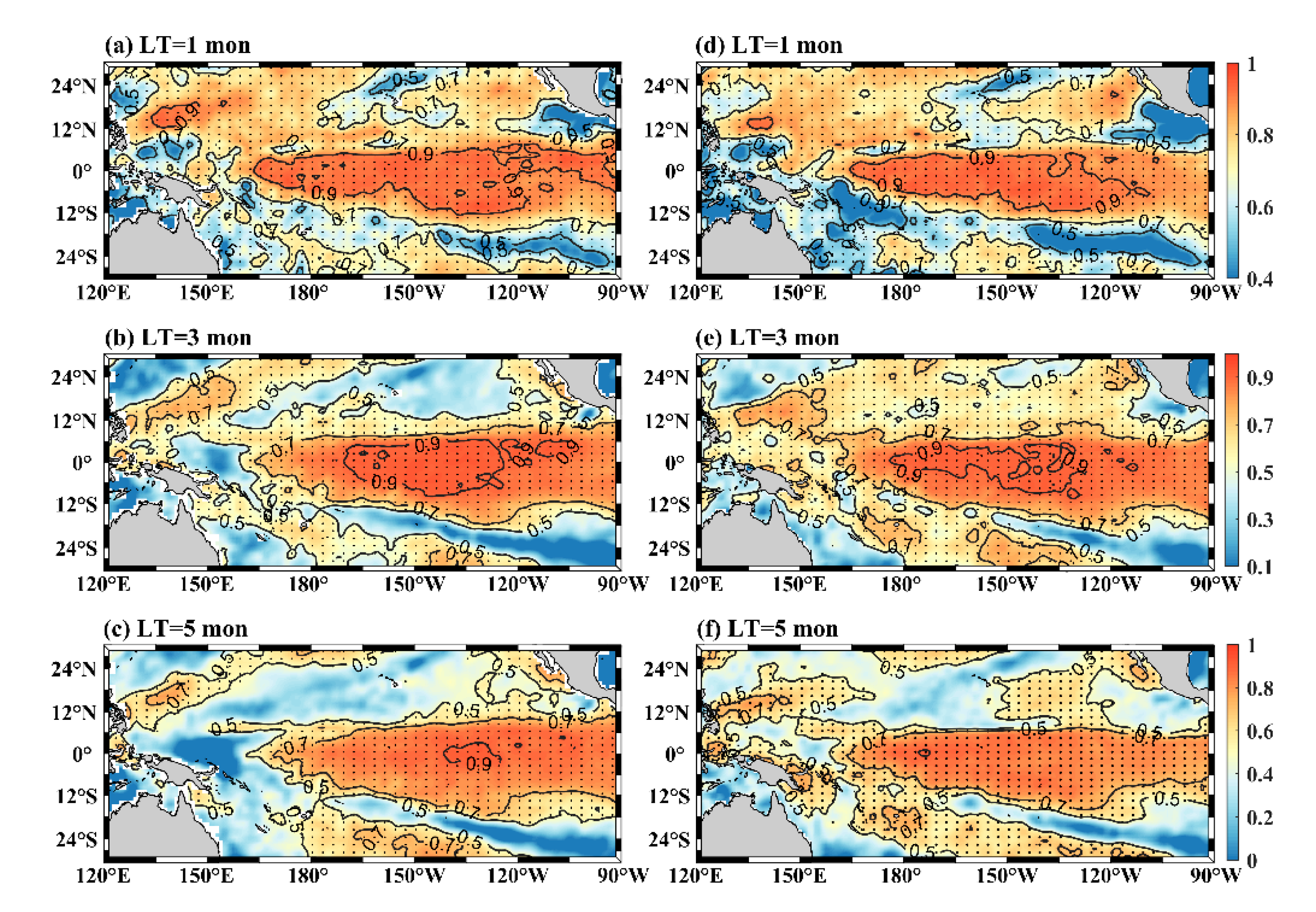

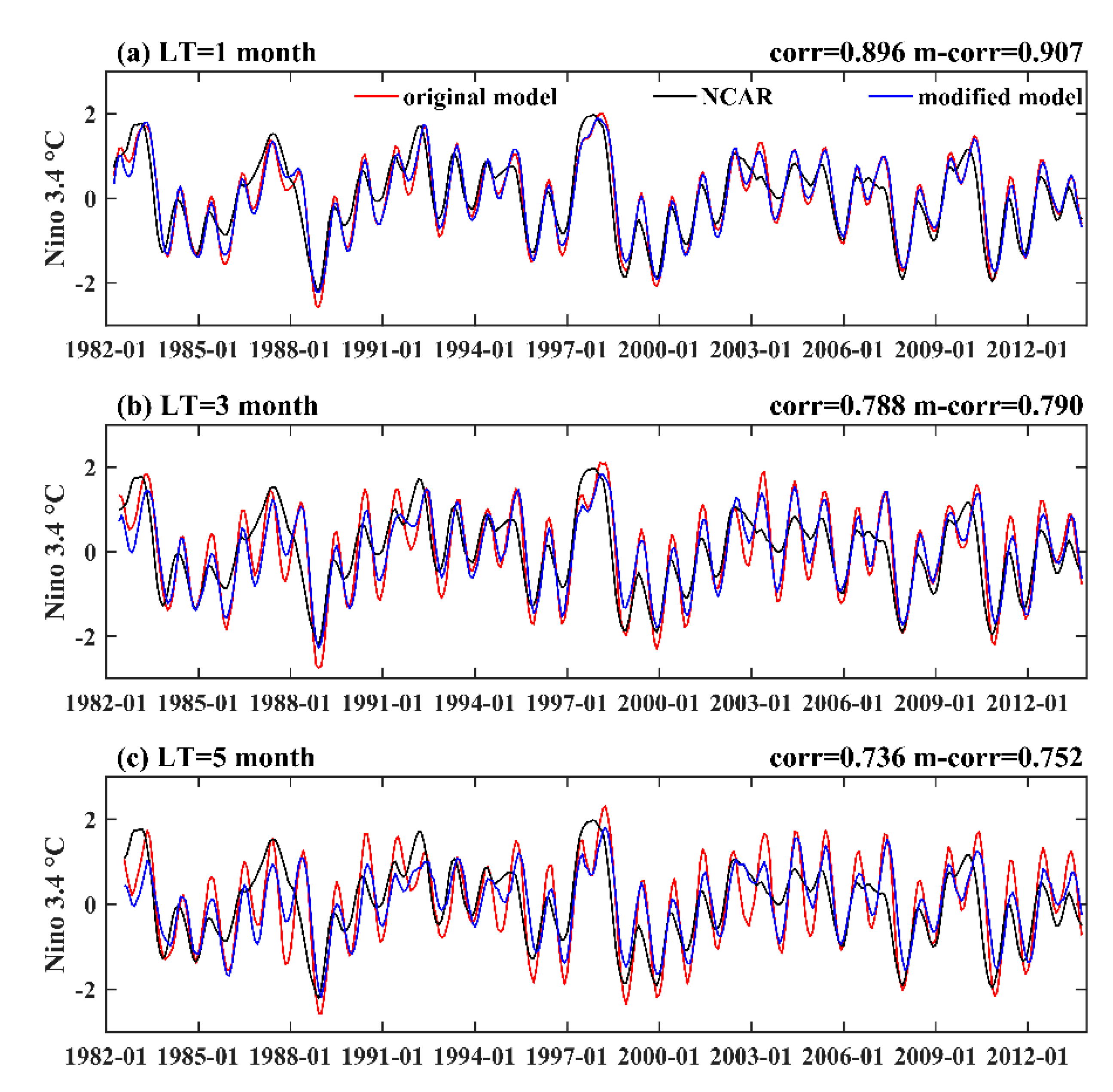
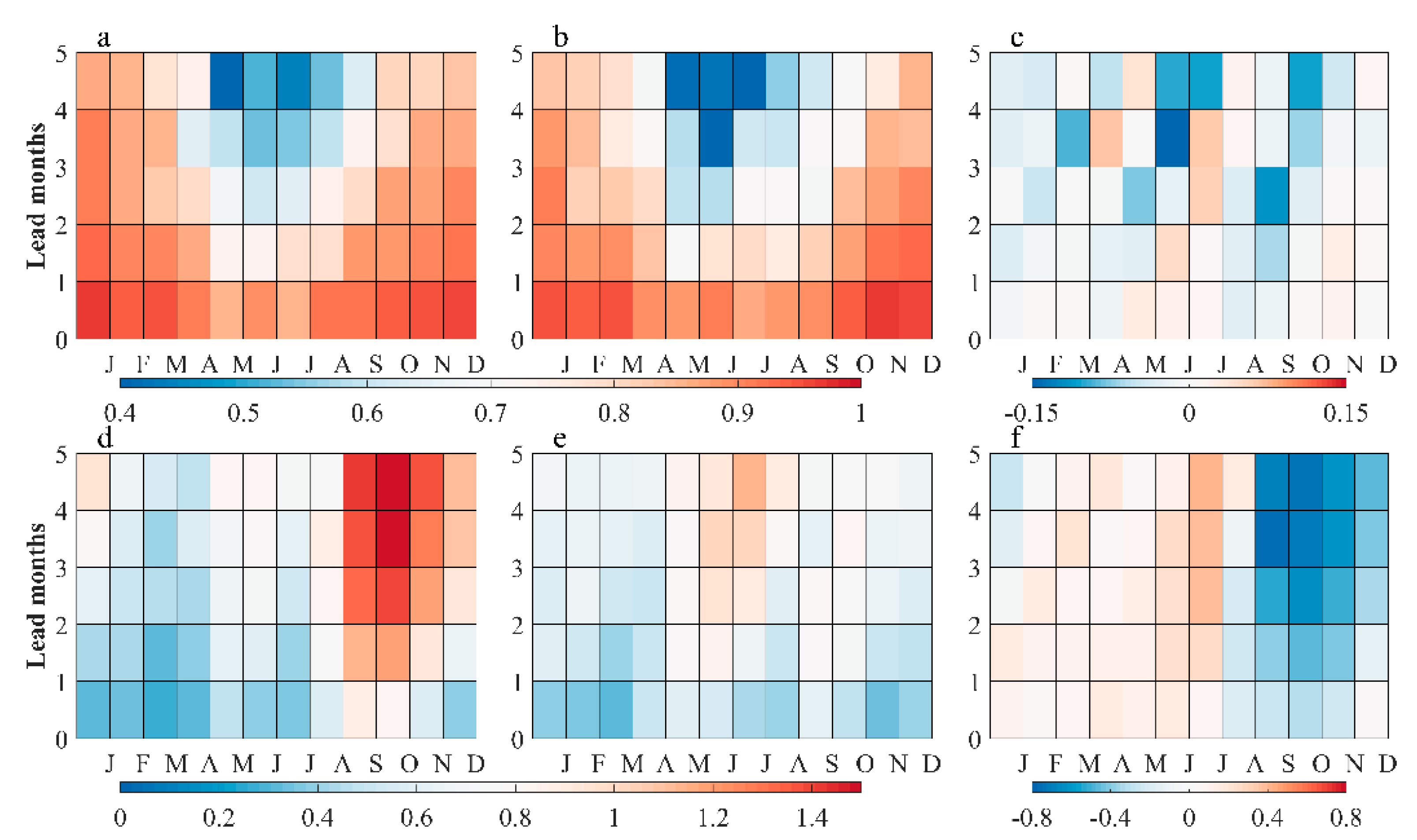
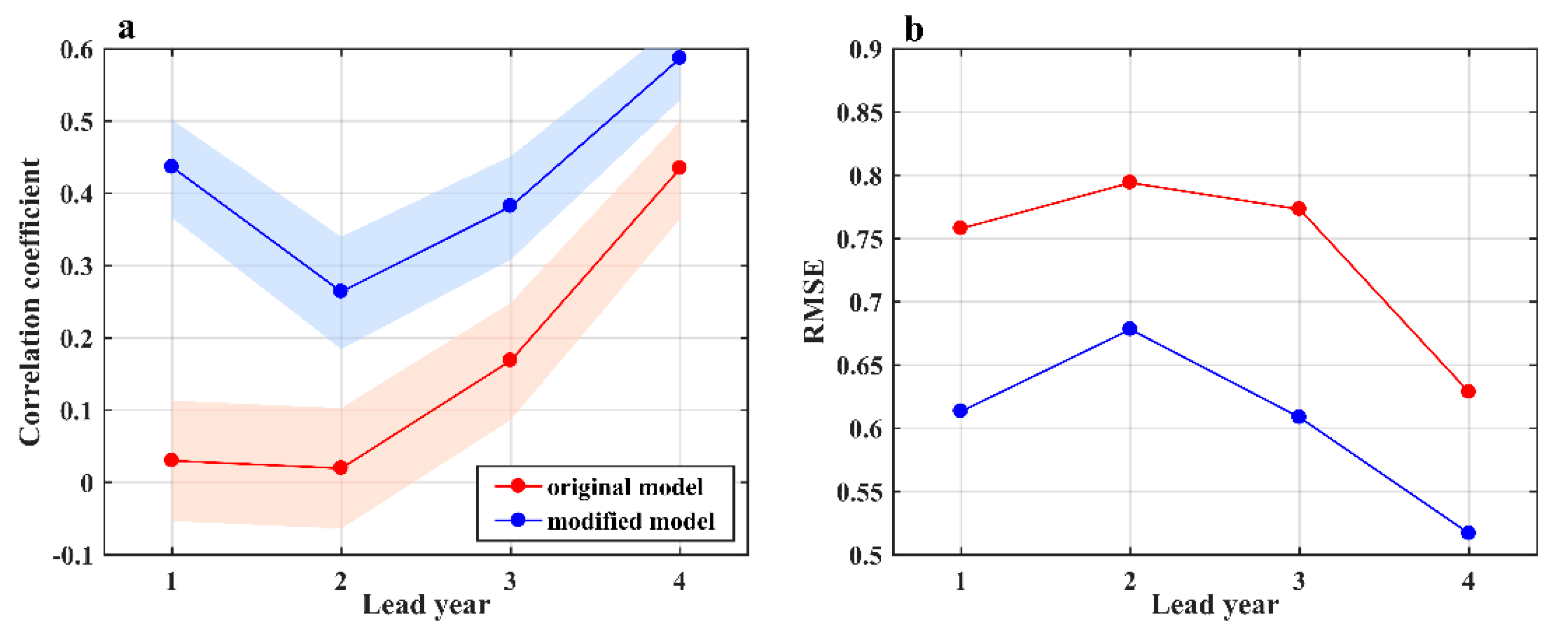
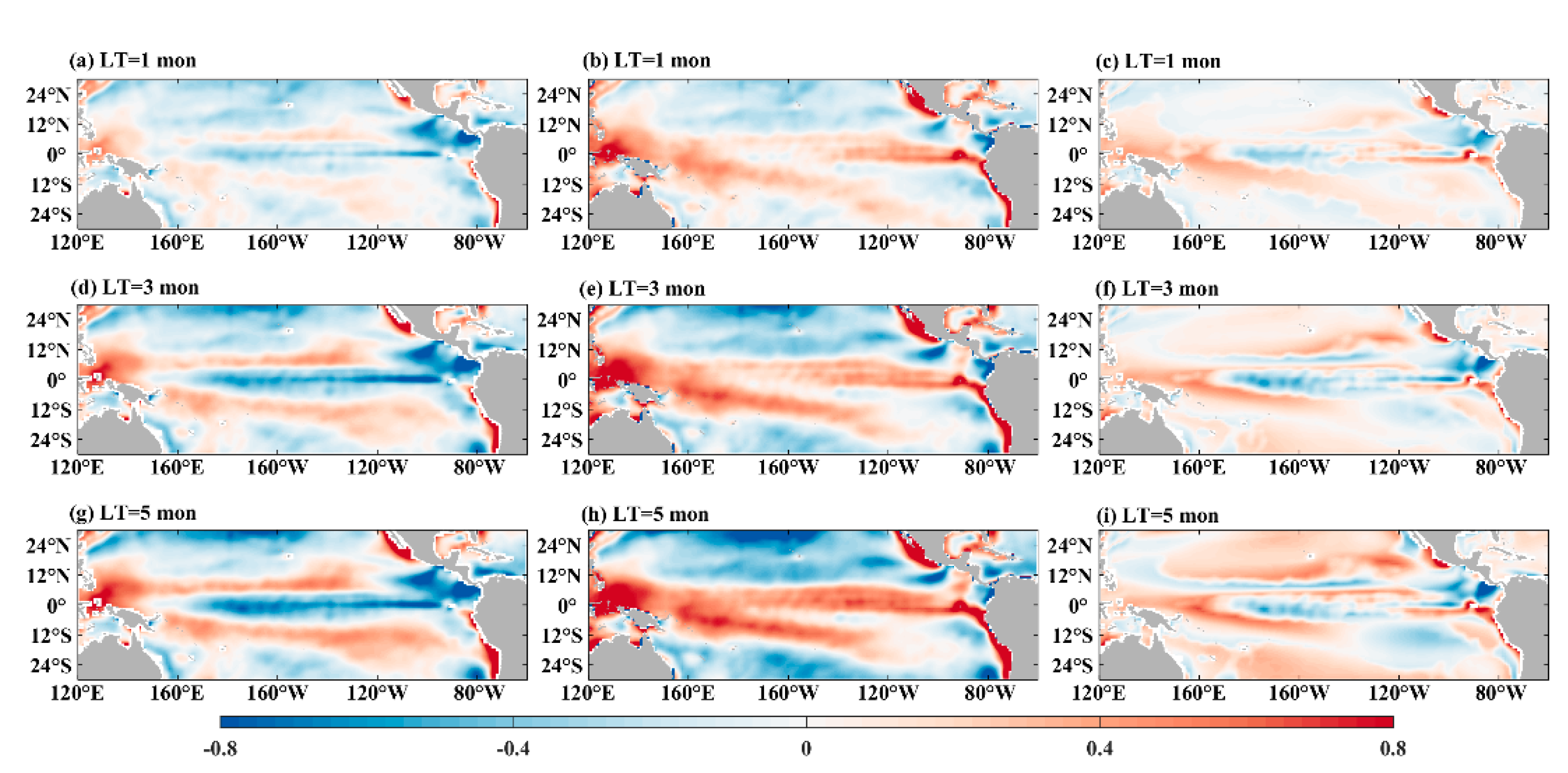
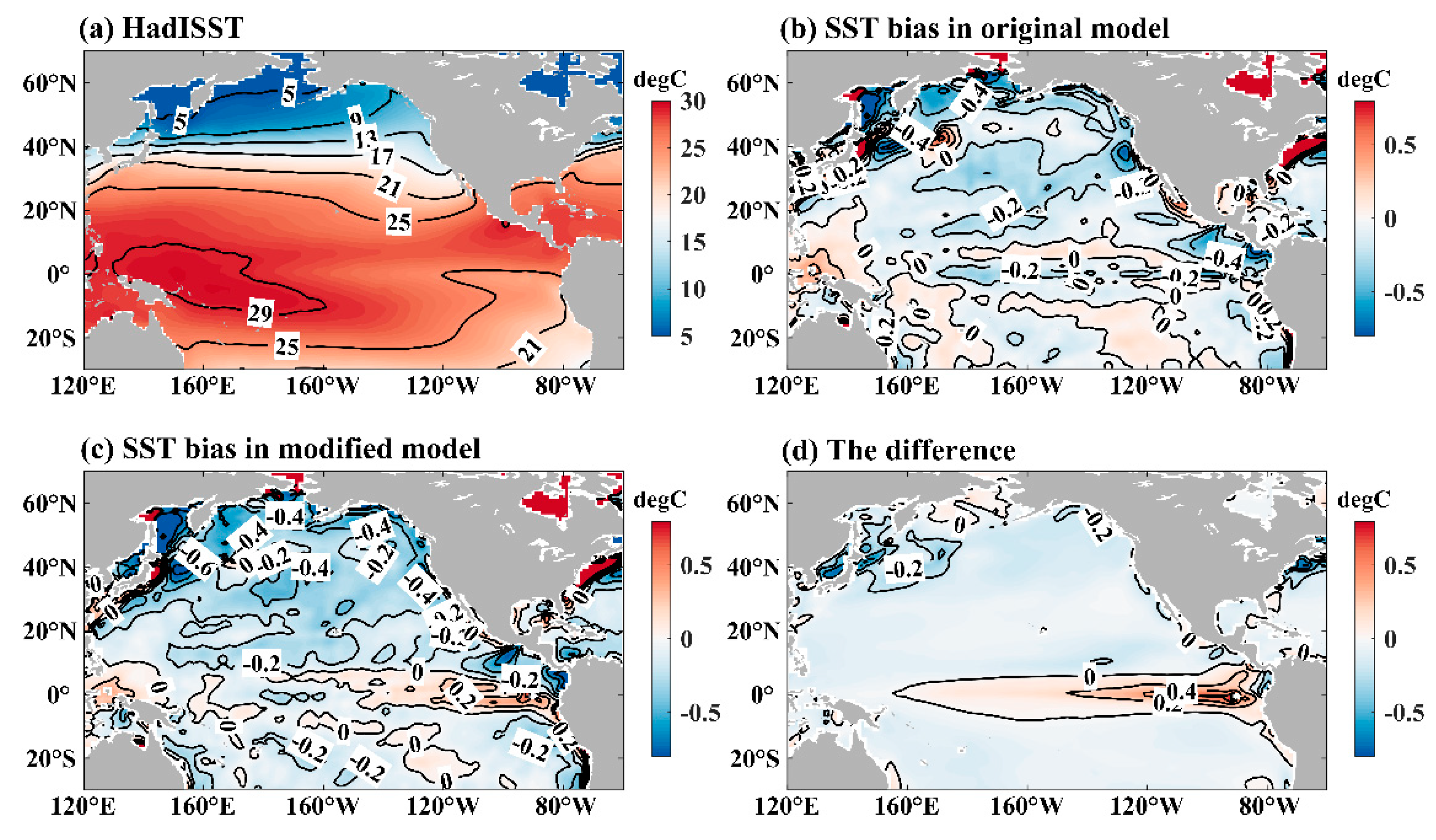
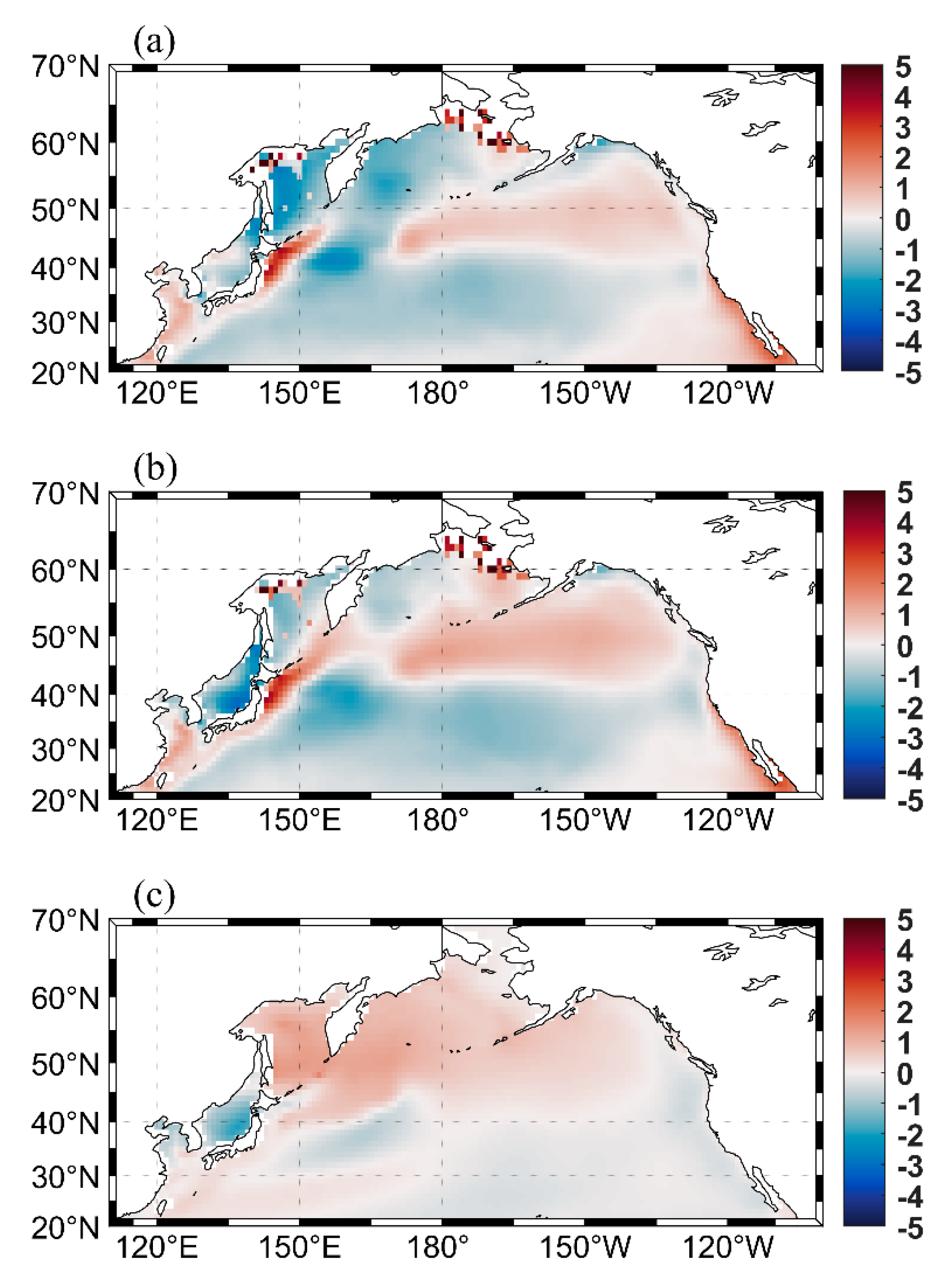
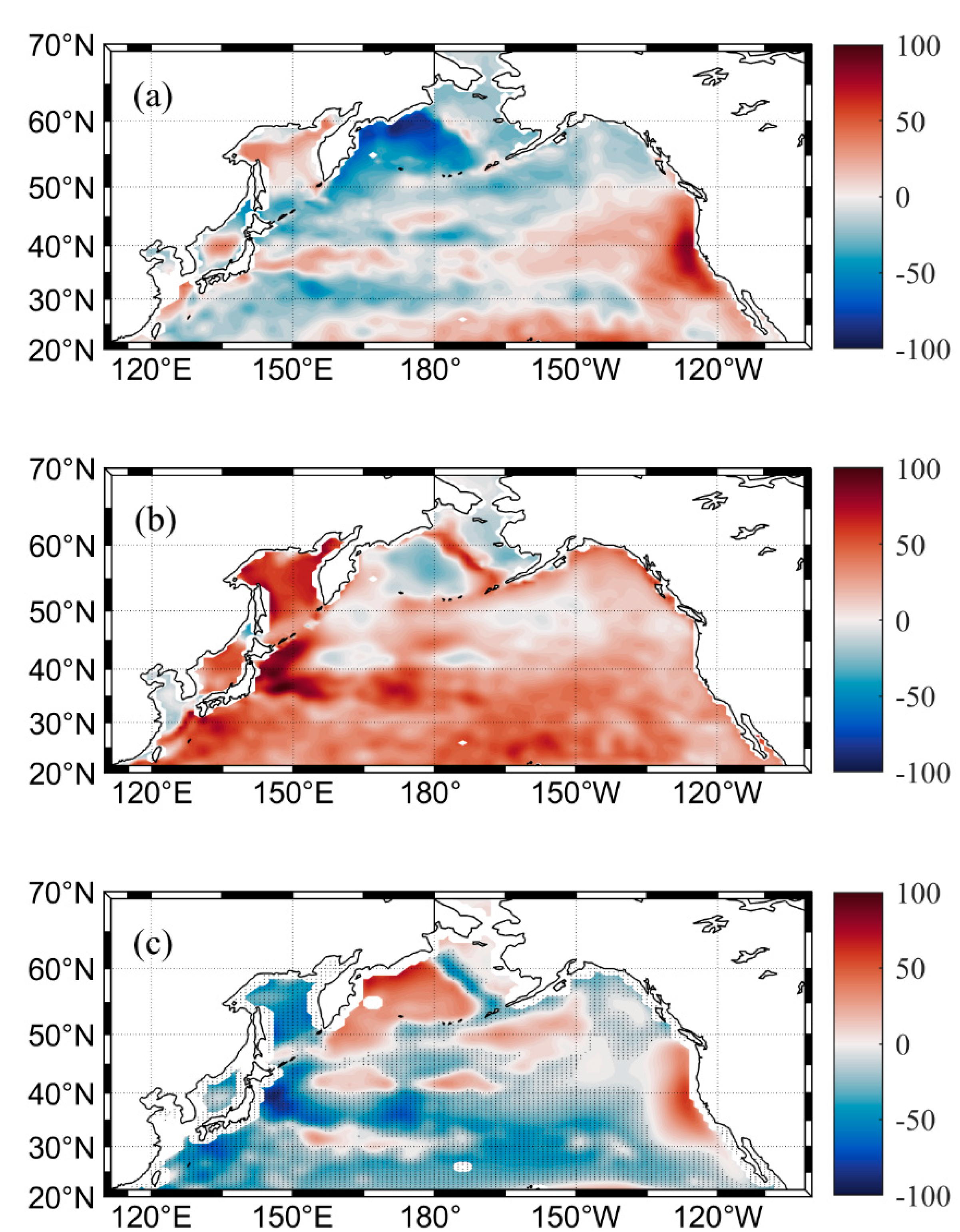
| CONTROL | SENSI | ||
|---|---|---|---|
| Historical Assimilation Experiment | Time | 1961–2016 | 1961–2016 |
| Assimilation Data | 1961–1982: COBE SST1982–2016: AVHRR SST | 1961–1982: COBE SST1982–2016: AVHRR SST | |
| ENSO Prediction Experiment | Time | 1982–2016 | 1982–2016 |
| Start time | 1st of every month | 1st of every month | |
| Predicted time | 7 months | 7 months | |
| PDO Prediction Experiment | Time | 1961–2016 | 1961–2016 |
| Start time | 1 November every year | 1 November every year | |
| Predicted time | 5 years | 5 years |
Publisher’s Note: MDPI stays neutral with regard to jurisdictional claims in published maps and institutional affiliations. |
© 2022 by the authors. Licensee MDPI, Basel, Switzerland. This article is an open access article distributed under the terms and conditions of the Creative Commons Attribution (CC BY) license (https://creativecommons.org/licenses/by/4.0/).
Share and Cite
Yang, Y.; Hu, X.; Liao, G.; Cao, Q.; Chen, S.; Gao, H.; Wei, X. Improved ENSO and PDO Prediction Skill Resulting from Finer Parameterization Schemes in a CGCM. Remote Sens. 2022, 14, 3363. https://doi.org/10.3390/rs14143363
Yang Y, Hu X, Liao G, Cao Q, Chen S, Gao H, Wei X. Improved ENSO and PDO Prediction Skill Resulting from Finer Parameterization Schemes in a CGCM. Remote Sensing. 2022; 14(14):3363. https://doi.org/10.3390/rs14143363
Chicago/Turabian StyleYang, Yuxing, Xiaokai Hu, Guanghong Liao, Qian Cao, Sijie Chen, Hui Gao, and Xiaowei Wei. 2022. "Improved ENSO and PDO Prediction Skill Resulting from Finer Parameterization Schemes in a CGCM" Remote Sensing 14, no. 14: 3363. https://doi.org/10.3390/rs14143363






